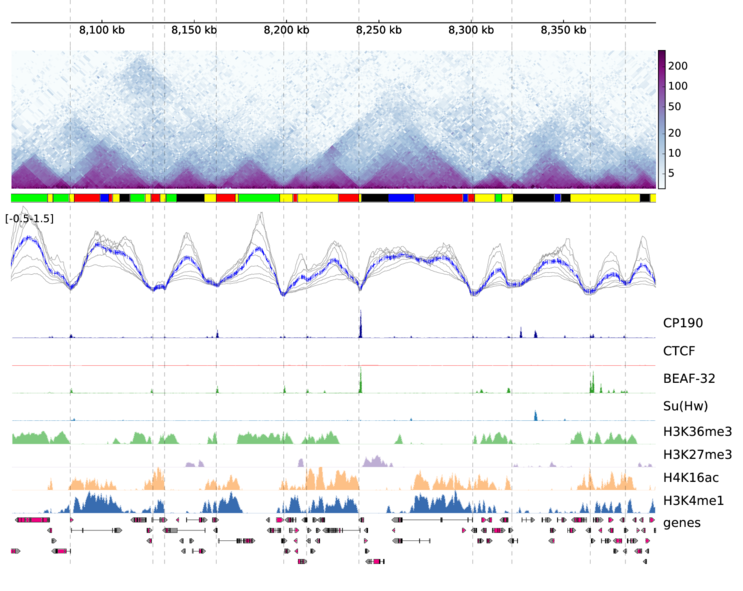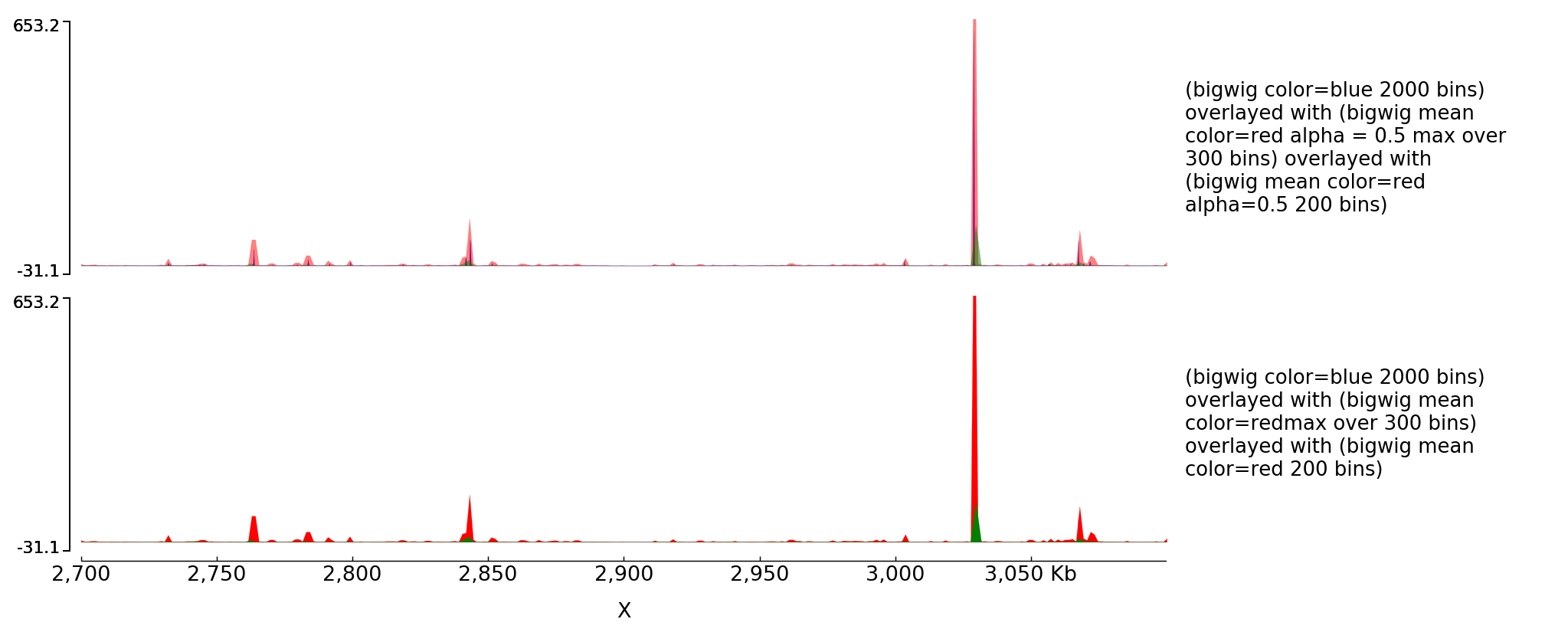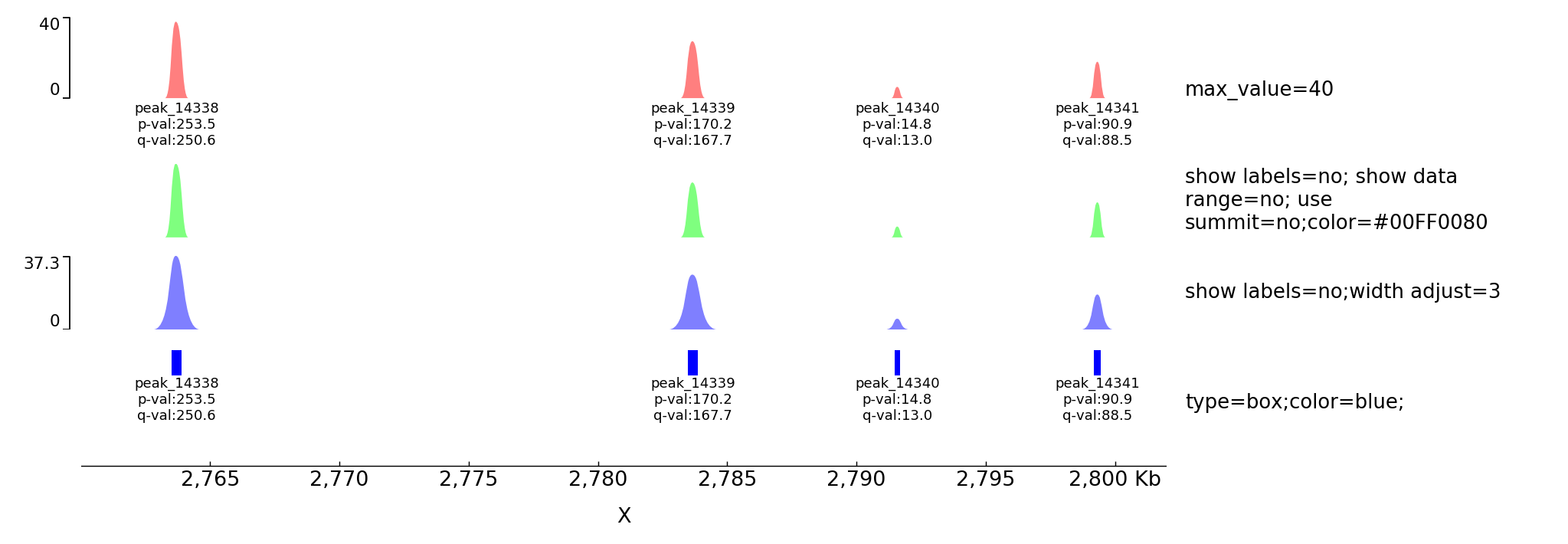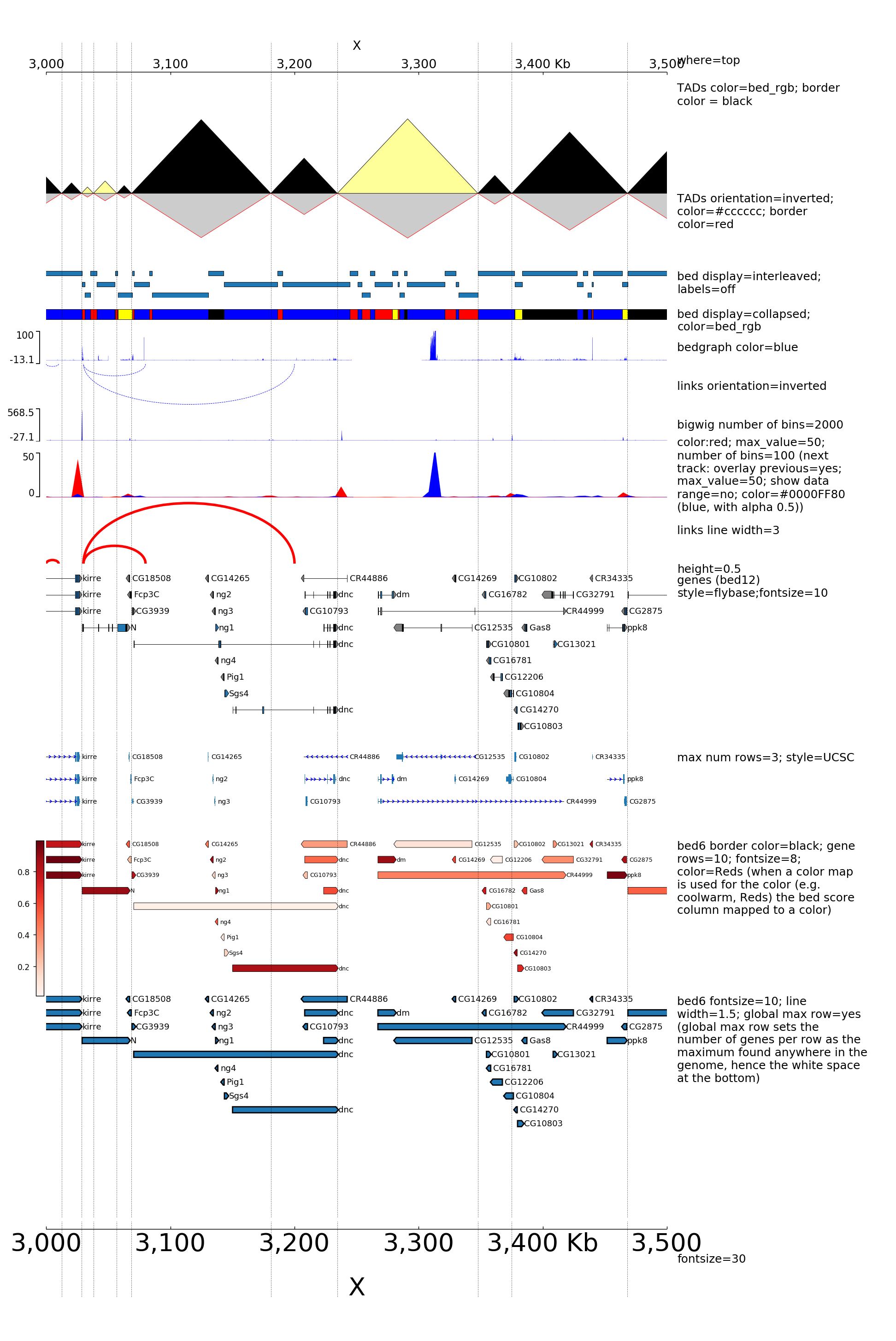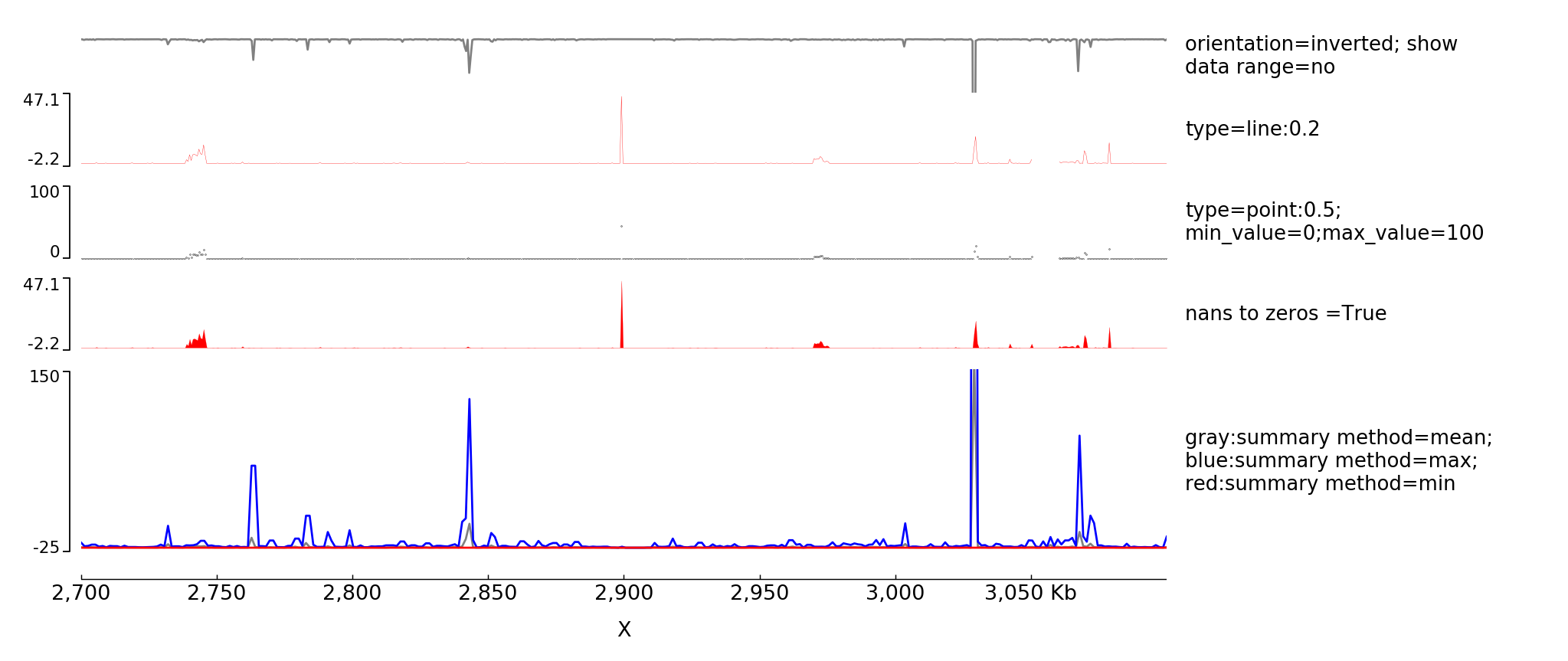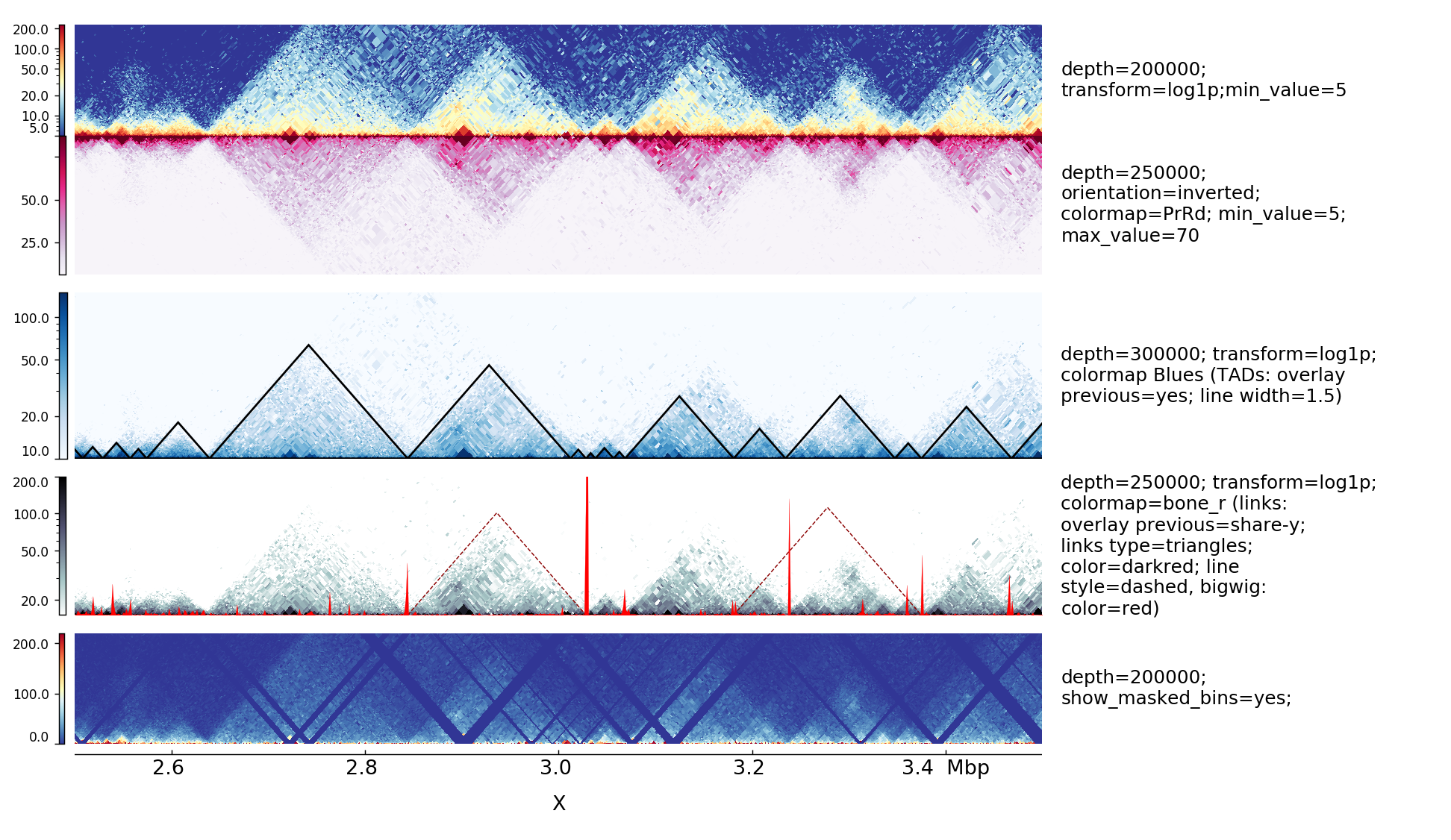pyGenomeTracks aims to produce high-quality genome browser tracks that are highly customizable. Currently, it is possible to plot:
- bigwig
- bed/gtf (many options)
- bedgraph
- epilogos
- narrow peaks
- links (represented as arcs)
- Hi-C matrices
pyGenomeTracks can make plots with or without Hi-C data. The following is an example output of pyGenomeTracks from Ramírez et al. 2017
pyGenomeTracks works with python >=3.6.
Currently, the best way to install pyGenomeTracks is with anaconda
$ conda install -c bioconda pygenometracksAlso, pyGenomeTracks can be installed using pip
$ pip install pyGenomeTracksIf the latest version wants to be installed use:
$ pip install git+https://github.com/deeptools/pyGenomeTracks.gitTo run pyGenomeTracks a configuration file describing the tracks is required. The easiest way to create this file is using the program make_tracks_file which creates a configuration file with
defaults that can be easily changed. The format is:
$ make_tracks_file --trackFiles <file1.bed> <file2.bw> ... -o tracks.inimake_tracks_file uses the file ending to guess the file type.
Then, a region can be plotted using:
$ pyGenomeTracks --tracks tracks.ini --region chr2:10,000,000-11,000,000 --outFileName nice_image.pdfThe ending --outFileName defines the image format. If .pdf is used, then the resulting image is a pdf. The options are pdf, png and svg.
If you use pyGenomeTracks in your analysis, you can cite the following paper :
Fidel Ramírez, Vivek Bhardwaj, Laura Arrigoni, Kin Chung Lam, Björn A. Grüning, José Villaveces, Bianca Habermann, Asifa Akhtar & Thomas Manke. High-resolution TADs reveal DNA sequences underlying genome organization in flies. Nature Communications (2018) doi:10.1038/s41467-017-02525-w
(These examples are found in the examples/ folder)
A minimal example of a configuration file with a single bigwig track looks like this:
[bigwig file test]
file = bigwig.bw
# height of the track in cm (optional value)
height = 4
title = bigwig
min_value = 0
max_value = 30$ pyGenomeTracks --tracks bigwig_track.ini --region X:2,500,000-3,000,000 -o bigwig.pngNow, let's add the genomic location and some genes:
[bigwig file test]
file = bigwig.bw
# height of the track in cm (optional value)
height = 4
title = bigwig
min_value = 0
max_value = 30
[spacer]
# this simply adds an small space between the two tracks.
[genes]
file = genes.bed.gz
height = 7
title = genes
fontsize = 10
file_type = bed
gene rows = 10
[x-axis]
fontsize=10$ pyGenomeTracks --tracks bigwig_with_genes.ini --region X:2,800,000-3,100,000 -o bigwig_with_genes.pngNow, we will add some vertical lines across all tracks. The vertical lines should be in a bed format.
[bigwig file test]
file = bigwig.bw
# height of the track in cm (optional value)
height = 4
title = bigwig
min_value = 0
max_value = 30
[spacer]
# this simply adds an small space between the two tracks.
[genes]
file = genes.bed.gz
height = 7
title = genes
fontsize = 10
file_type = bed
gene rows = 10
[x-axis]
fontsize=10
[vlines]
file = domains.bed
type = vlines$ pyGenomeTracks --tracks bigwig_with_genes_and_vlines.ini --region X:2,800,000-3,100,000 -o bigwig_with_genes_and_vlines.pngYou can also overlay bigwig with or without transparency.
[test bigwig]
file = bigwig2_X_2.5e6_3.5e6.bw
color = blue
height = 7
title = (bigwig color=blue 2000 bins) overlayed with (bigwig mean color=red alpha = 0.5 max over 300 bins) overlayed with (bigwig mean color=red alpha=0.5 200 bins)
number of bins = 2000
[test bigwig max]
file = bigwig2_X_2.5e6_3.5e6.bw
color = red
alpha = 0.5
summary method = max
number of bins = 300
overlay previous = share-y
[test bigwig mean]
file = bigwig2_X_2.5e6_3.5e6.bw
color = green
alpha = 0.5
type = fill
number of bins = 200
overlay previous = share-y
[spacer]
[test bigwig]
file = bigwig2_X_2.5e6_3.5e6.bw
color = blue
height = 7
title = (bigwig color=blue 2000 bins) overlayed with (bigwig mean color=redmax over 300 bins) overlayed with (bigwig mean color=red 200 bins)
number of bins = 2000
[test bigwig max]
file = bigwig2_X_2.5e6_3.5e6.bw
color = red
summary method = max
number of bins = 300
overlay previous = share-y
[test bigwig mean]
file = bigwig2_X_2.5e6_3.5e6.bw
color = green
type = fill
number of bins = 200
overlay previous = share-y
[x-axis]$ pyGenomeTracks --tracks alpha.ini --region X:2700000-3100000 -o master_alpha.pngpyGenomeTracks has an option to plot peaks using MACS2 narrowPeak format.
The following is an example of the output in which the peak shape is drawn based on the start, end, summit and height of the peak.
[narrow]
file = test.narrowPeak
height = 4
max_value = 40
title = max_value=40
[narrow 2]
file = test.narrowPeak
height = 2
show labels = no
show data range = no
color = #00FF0080
use summit = no
title = show labels=no; show data range=no; use summit=no;color=#00FF0080
[spacer]
[narrow 3]
file = test.narrowPeak
height = 2
show labels = no
color = #0000FF80
use summit = no
width adjust = 4
title = show labels=no;width adjust=3
[spacer]
[narrow 4]
file = test.narrowPeak
height = 3
type = box
color = blue
title = type=box;color=blue;
[x-axis]The following is an example with Hi-C data overlay with topologically associating domains (TADs) and a bigwig file.
[x-axis]
where = top
[hic matrix]
file = hic_data.h5
title = Hi-C data
# depth is the maximum distance plotted in bp. In Hi-C tracks
# the height of the track is calculated based on the depth such
# that the matrix does not look deformated
depth = 300000
transform = log1p
file_type = hic_matrix
[tads]
file = domains.bed
display = triangles
border color = black
color = none
# the tads are overlay over the hic-matrix
# the share-y options sets the y-axis to be shared
# between the Hi-C matrix and the TADs.
overlay previous = share-y
[spacer]
[bigwig file test]
file = bigwig.bw
# height of the track in cm (optional value)
height = 4
title = ChIP-seq
min_value = 0
max_value = 30
$ pyGenomeTracks --tracks hic_track.ini -o hic_track.png --region chrX:2500000-3500000pyGenomeTracks can be used to visualize epigenetic states (for example from chromHMM) as epilogos. For more information see: https://epilogos.altiusinstitute.org/
To plot epilogos a qcat file is needed. This file can be crated using the epilogos software (https://github.com/Altius/epilogos).
An example track file for epilogos looks like:
[epilogos]
file = epilog.qcat.bgz
height = 5
title = epilogos
[x-axis]The color of the bars can be set by using a json file. The structure of the file is like this
{
"categories":{
"1":["Active TSS","#ff0000"],
"2":["Flanking Active TSS","#ff4500"],
"3":["Transcr at gene 5\" and 3\"","#32cd32"],
"4":["Strong transcription","#008000"]
}
}In the following examples the top epilogo has the custom colors and the one below is shown inverted.
[epilogos]
file = epilog.qcat.bgz
height = 5
title = epilogos with custom colors
categories_file = epilog_cats.json
[epilogos inverted]
file = epilog.qcat.bgz
height = 5
title = epilogos inverted
orientation = inverted
[x-axis]A comprehensive example of pyGenomeTracks can be found as part of our automatic testing.
Note, that pyGenome tracks also allows the combination of multiple tracks into one using the parameter: overlay previous=yes or overlay previous=share-y.
In the second option the y-axis of the tracks that overlays is the same as the track being overlay. Multiple tracks can be overlay together.
The configuration file for this image is here
The configuration file for this image is here
In these examples is where the overlay tracks are more useful. Notice that any track can be overlay over a Hi-C matrix. Most useful is to overlay TADs or to overlay links using the triangles option
that will point in the Hi-C matrix the pixel with the link contact. When overlaying links and TADs is useful to set overlay previous=share-y such that the two tracks match the positions. This is not
required when overlying other type of data like a bigwig file that has a different y-scale.
The configuration file for this image is here
Adding new tracks to pyGenomeTracks only requires adding a new class to the pygenometracks/tracks folder.
The class should inherit the the GenomeTrack (or other track class available) and should have a plot method.
Additionally, some basic description should be added.
For example, to make a track that prints 'hello world' at a given location looks like this:
class TextTrack(GenomeTrack):
SUPPORTED_ENDINGS = ['.txt'] # this is used by make_tracks_file to guess the type of track based on file name
TRACK_TYPE = 'text'
OPTIONS_TXT = """
height = 3
title =
text =
# x position of text in the plot (in bp)
x position =
"""
def plot(self, ax, chrom, region_start, region_end):
"""
This example simply plots the given title at a fixed
location in the axis. The chrom, region_start and region_end
variables are not used.
Args:
ax: matplotlib axis to plot
chrom_region: chromosome name
start_region: start coordinate of genomic position
end_region: end coordinate
"""
# print text at position x = self.properties['x position'] and y = 0.5 (center of the plot)
ax.text(float(self.properties['x position']), 0.5, self.properties['text'])The OPTIONS_TXT should contain the text to build a default configuration file.
This information, together with the information about SUPPORTED_ENDINGS is used
by the program make_tracks_file to create a default configuration file
based on the endings of the files given.
The configuration file is:
[x-axis]
where = top
[new track]
file =
height = 4
title = new pyGenomeTrack
file_type = text
text = hello world
x position = 3100000# pgt is short for `pyGenomeTracks`
pgt --tracks new_track.ini --region X:3000000-3200000 -o new_track.pngNotice that the resulting track already includes a y-axis (to the left) and
a label to the right. This are the defaults that can be changed by
adding a plot_y_axis and plot_label methods.
Another more complex example is the plotting of multiple bedgraph data as matrices. The output of HiCExplorer hicFindTADs produces a data format that
is similar to a bedgraph but with more value columns. We call this a bedgraph matrix. The following track plot this bedgraph matrix:
import numpy as np
from . BedGraphTrack import BedGraphTrack
class BedGraphMatrixTrack(BedGraphTrack):
# this track class extends a BedGraphTrack that is already part of
# pyGenomeTracks. The advantage of extending this class is that
# we can re-use the code for reading a bedgraph file
SUPPORTED_ENDINGS = ['.bm', '.bm.gz']
TRACK_TYPE = 'bedgraph_matrix'
OPTIONS_TXT = GenomeTrack.OPTIONS_TXT + """
# a bedgraph matrix file is like a bedgraph, except that per bin there
# are more than one value (separated by tab). This file type is
# produced by the HiCExplorer tool hicFindTads and contains
# the TAD-separation score at different window sizes.
# E.g.
# chrX 18279 40131 0.399113 0.364118 0.320857 0.274307
# chrX 40132 54262 0.479340 0.425471 0.366541 0.324736
#min_value = 0.10
#max_value = 0.70
file_type = {}
""".format(TRACK_TYPE)
def plot(self, ax, chrom_region, start_region, end_region):
"""
Args:
ax: matplotlib axis to plot
chrom_region: chromosome name
start_region: start coordinate of genomic position
end_region: end coordinate
"""
start_pos = []
matrix_rows = []
# the BedGraphTrack already has methods to read files
# in which the first three columns are chrom, start,end
# here we used the interval_tree method inherited from the
# BedGraphTrack class
for region in sorted(self.interval_tree[chrom_region][start_region - 10000:end_region + 10000]):
start_pos.append(region.begin)
# the region.data contains all the values for a given region
# In the following code, such list is converted to floats and
# appended to a new list.
values = list(map(float, region.data))
matrix_rows.append(values)
# using numpy, the list of values per line in the bedgraph file
# is converted into a matrix whose columns contain
# the bedgraph values for the same line (notice that
# the matrix is transposed to achieve this)
matrix = np.vstack(matrix_rows).T
# using meshgrid we get x and y positions to plot the matrix at
# corresponding positions given in the bedgraph file.
x, y = np.meshgrid(start_pos, np.arange(matrix.shape[0]))
# shading adds some smoothing to the pllot
shading = 'gouraud'
vmax = self.properties['max_value']
vmin = self.properties['min_value']
img = ax.pcolormesh(x, y, matrix, vmin=vmin, vmax=vmax, shading=shading)
img.set_rasterized(True)
def plot_y_axis(self, ax, plot_axis):
"""turn off y_axis plot"
passLet's create a track for this:
[bedgraph matrix]
file = tad_separation_score.bm.gz
title = bedgraph matrix
height = 8
file_type = bedgraph_matrix
[spacer]
[x-axis]pgt --tracks bedgraph_matrix.ini --region X:2000000-3500000 -o bedgraph_matrix.pngAlthough this image looks interesting another way to plot
the data is a overlapping lines with the mean value highlighted.
Using the bedgraph version of pyGenomeTracks the following image
can be obtained:
pyGenomeTracks is used by HiCExporer and HiCBrowser (See e.g. Chorogenome navigator which is made with HiCBrowser)



